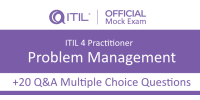Exam Glossary
| Term | Main definition |
|---|---|
| availability management practice | The practice of ensuring that services deliver agreed levels of availability to meet the needs of customers and users. |
| availability | The ability of an IT service or other configuration item to perform its agreed function when required. |
| asset register | A database or list of assets, capturing key attributes such as ownership and financial value. |
| artificial intelligence | Highly advanced automation that demonstrates capabilities of general reasoning, learning, and human-like intelligence; a branch of computer science and engineering focused on simulating intelligent behaviour in |
| architecture management practice | The practice of providing an understanding of all the different elements that make up an organization and how those elements relate to one another. |
| andon | A system, either manual or automated, used to notify workers and other parts of an organization of quality or process issues. The Andon system originated in manufacturing, but is now widely used in IT. |
| AIOps | The application of machine learning and big data to IT operations to receive continuous insights which provide continuous fixes and improvements via automation. Also referred to as ‘artificial intelligence for IT operations’ or ‘algorithmic IT operations’. |
| agile | An umbrella term for a collection of frameworks and techniques that together enable teams and individuals to work in a way that is typified by collaboration, prioritization, iterative and incremental delivery, and timeboxing. There are several specific methods (or frameworks) that are classed as Agile, such as Scrum, Lean, and Kanban. |
| adaptive system | A system in which the behaviour of agents changes and they self-organize in response to events. |
| acceptance criteria | A list of minimum requirements that a service or service component must meet for it to be acceptable to key stakeholders. |
| absorptive capacity | An organization’s ability to recognize the value of new information, embed it into an existing knowledge system, and apply it to achieve the intended business outcomes. |






